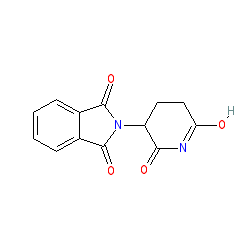GtoPdb is requesting financial support from commercial users. Please see our sustainability page for more information.
|
Synonyms: K-17
thalidomide is an approved drug (FDA (1998), EMA (2008))
Compound class:
Synthetic organic
Comment: Thalidomide is principally an immunomodulatory drug. It inhibits synthesis of TNFα. Mechanistically, thalidomide binds to cereblon, and this complex recruits substrate proteins for degradation by the ubiquitin system. The lymphoid transcription factors Ikaros (IKZF1) and Aiolos (IKZF3) have been identified as substrates for thalidomide-bound cereblon. More recently another transcription factor, PLZF (ZBTB16), has been reported as a potential thalidomide/cereblon substrate [7]. Knockdown of Plfz induces skeletal abnormalities in chicken limbs, so thalidomide-targeted degradation of PLZF would be predicted to exhibit similar teratogenic effects.
SARS-CoV-2 and COVID-19: Thalidomide + low-dose glucocorticoid is being evaluated for efficacy in severe COVID-19 pneumonia (preprint available here https://www.preprints.org/manuscript/202002.0395/v1). An alternative approach is examining the combination of thalidomide + celecoxib (which targets NF-κB to suppress production of inflammatory cytokines; see preprint DOI: 10.13140/RG.2.2.26979.91689). Ligand Activity Visualisation ChartsThese are box plot that provide a unique visualisation, summarising all the activity data for a ligand taken from ChEMBL and GtoPdb across multiple targets and species. Click on a plot to see the median, interquartile range, low and high data points. A value of zero indicates that no data are available. A separate chart is created for each target, and where possible the algorithm tries to merge ChEMBL and GtoPdb targets by matching them on name and UniProt accession, for each available species. However, please note that inconsistency in naming of targets may lead to data for the same target being reported across multiple charts. ✖ |
|
|||||||||||||||||||||||||||||||||||
| No information available. |
Summary of Clinical Use  |
| Thalidomide was originally used treat nausea and alleviate morning sickness in pregnant women. Unfortunately the drug was found to be a powerful human teratogen, causing severe embryopathy, principally malformation of the limbs (phocomelia). This drug has undergone a remarkable metamorphosis, with thalidomide now being repurposed as a treatment for certain cancers (eg multiple myeloma, in combination with dexamethasone, or melphalan and prednisone) and for erythema nodosum leprosum (ENL), a complication of leprosy. As a condition of drug approval, authorising agencies stipulate that female patients with childbearing potential, requiring thalidomide treatment, be advised to use multiple forms of contraception and/or be counselled and educated regarding the risks associated with taking the drug, and the importance of avoiding pregnancy. They may also be offered regular pregnancy tests. EMA approval specifically for multiple myeloma treatment was granted in 2022. |
Mechanism Of Action and Pharmacodynamic Effects  |
| As an antineoplastic agent, thalidomide appears to inhibit the angiogenesis essential for tumour growth. Anti-inflammatory action may be due to supression of production of pro-inflammatory cytokines and enhanced production of anti-inflammatory cytokines such as IL-10 [5]. The primary target of thalidomide is the cereblon protein (CRBM, Q96SW2) [4,6], which has been linked to the teratogenic activity of the thalidomide-like drugs [1-2]. Cereblon has multiple actions, including participation in protein ubiquitination complexes and regulation of potassium channels [1,3]. |
External links  |
|
For extended ADME data see the following: Electronic Medicines Compendium (eMC) Drugs.com European Medicines Agency (EMA) |









